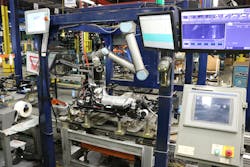Automotive Supplier Calls on Cobot for Critical Inspection
Comprehensive Logistics is an automotive logistics and contract manufacturer that produces suspension, powertrain and interior component sub-assemblies for two of North America’s largest automotive enterprises. When the company needed a more repeatable way to perform inspections on its engine cradle sub-assembly line in Youngstown, Ohio, it found the answer in a collaborative robot (cobot) from Universal Robots.
Cobots are popping up in manufacturing circles like Shasta daisies in the spring, appearing in the pharmaceutical, packaging, and food and beverage industries with increasing frequency. A 2018 report from Loup Ventures predicts that 34 percent of all robotic sales in 2025 will be cobots, up from last year’s 3 percent. A lower price tag for cobots and new applications are only two reasons for the sunny projections.
The challenge for Comprehensive Logistics was automating its inspection of an engine cradle sub-assembly that includes a critical steering-gear wire harness connector. The automated inspection system also needed to keep pace with the line’s high volumes while ensuring a proper connection with the electrical connectors inside the wire harness.
Initially, the automotive manufacturer employed a stationary, multi-camera system that couldn’t position the cameras into tight spots and deliver repeatable results. “The data gathered by the stationary camera system wasn’t as pure,” says Mike O’Keefe, value-added assembly superintendent at Comprehensive Logistics. The company also experimented with a probe-style robot and manual inspection routines, neither of which improved repeatability.
“If there is an intermittent loose connection or it’s connected and not locked into place, it can cause a complete loss of the power steering,” O’Keefe says. “For automakers, this is a Level 8 on the severity scale.”
Enter Universal Robots’ largest cobot, the UR10, and Keyence’s CV-X camera, part of the CA-HX200C LumiTrax vision system, to navigate the “wiring cave” of the sub-assembly units and deliver repeatable inspection results. The ceiling-mounted UR10 cobot moves quickly between inspection points, enabling the CV-X camera to snap a picture of each connection before the cobot arm retracts to a home position, and waits for the next assembly to inspect.
During the inspection of the sub-assemblies, each image is immediately shown on a screen next to the robot while a second screen with a diagram of the engine cradle shows each inspection point completed with a green or a red check mark to indicate pass/failure. The company’s manufacturing execution system (MES) collects the pass/fail data and stores this information in a camera memory card for two days.
“The dexterity of the cobot enables it to find the mission-critical points and be 100 percent repeatable,” O’Keefe says. The contract manufacturer chose the UR10 cobot due to its 51-inch reach and built-in safety features.
Comprehensive Logistics’ assembly line produces engine cradle versions for both diesel and gas motors, with 11 and nine inspection points, respectively. Automation Zone, an Ohio-based certified system integrator of Universal Robots’ gear, configured the inspection system to recognize either engine product coming down the line. Specifically, the robot and camera system talk to the assembly line programmable logic controller (PLC) via the EtherNet/IP protocol to identify different engine types and other critical data.
According to Comprehensive Logistics, the system will run the first pass on all inspection points and, if one parameter fails, the system resets. “If the inspection fails, we can go in and review just the failed portion of the cycle,” O’Keefe says. “Typically, a stand-alone robot will rerun the entire process and exceed the needed cycle time.”
With a 60-second takt time at each station on the assembly line, the inspection cycle time runs for about 48 seconds, with the UR10 cobot taking approximately 32 seconds. This setup allows time for rerun fails without the whole assembly line coming to a standstill.
The overall inspection time is essential because Comprehensive Logistics receives just-in-time (JIT) orders from automakers. Over the past three years, the contract manufacturer has received more than 600,000 orders for sub-assembly-related engine products.
From a data management perspective, this innovative approach for inspection also provides Comprehensive Logistics the ability to manage and share critical quality information with OEMs in a timely fashion. As with many supply chain products in the automotive industry, OEMs set the inspection requirements and approved the final step for this implementation—a pass/fail confirmation. Comprehensive Logistics shares this data, when needed, with automakers via the company’s proprietary Streme warehouse management software system, which tracks inventory and materials as they flow through the facility.
Besides the flexibility and spatial benefits of Universal Robots’ cobot, the application allows Comprehensive Logistics to embrace safety with a “less is more” approach. The robot arm automatically stops operating if it encounters objects or people within its path. This feature is vital as operators will, at times, respond to inspection alerts from the inspection station.
With these kinds of attributes and features, the sunny growth projections by market analysts could hit the mark sooner than 2025.

